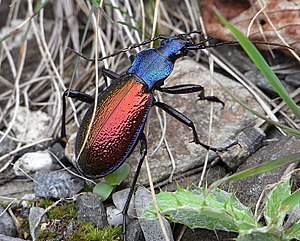Carabus hispanus
| Carabus hispanus | ||||||||||||
|---|---|---|---|---|---|---|---|---|---|---|---|---|

Carabus hispanus |
||||||||||||
| Systematics | ||||||||||||
|
||||||||||||
| Scientific name | ||||||||||||
| Carabus hispanus | ||||||||||||
| ( Fabricius , 1787) |
Carabus hispanus ( Syn .: Chrysocarabus hispanus ) is a beetle from the family of ground beetles (Carabidae). His scientific name is occasionally incorrectly translated into German as “Spanish ground beetle”, but the species name “hispanus” does not refer to Spain, but to the French town of Ispagnac . The beetle is only found in France. Among beetle breeders, the species oftentradesunderthe name Chrysotribax hispanus , and the name "Cevennesgroundbeetle" can also be found on the Internet.
The beetle species has a natural tendency to form hybrids with related species . Because of its bright metallic colors, the beetle is crossed by breeders with other brightly colored beetles in order to achieve new color variants.
features
Carabus hispanus shows the typical shape of the species-rich genus Carabus . It reaches a body length of 23 to 34 millimeters. The head and mouthparts face forward. The strong upper jaws are curved inwards and have a blunt tooth in the middle on the inner edge. Of the two pairs of jaw sensors , the front is two-limbed, the rear four-limbed. The lip buttons are tripartite. The end links of the rear jaw stylus and the lip stylus are greatly widened and flattened towards the front. The antennae are thread-shaped and eleven-limbed, the last seven limbs are finely hairy. They are turned in behind the base of the maxilla and in front of the compound eyes .
The pronotum is wider than the head and narrower than the elytra . It widens in the first third and is slightly constricted in the second third. Like the head, it is shiny, metallic blue and wrinkled slightly confused.
The elytra are elongated oval, slightly arched and flattened in a channel shape in front of the outer edge. Longitudinal keels are only indicated and covered by the coarse, flat wrinkles. The elytra are golden with red and greenish shades depending on the incidence of light, the edges are purple to purple. The change in color when exposed to light, which is known from some butterflies , is rare in beetles. The same animal is shown in the box at the top right and in Fig. 1. In Chrysocarabus , the color is determined by the thickness of the transparent exocuticle , its refractive index and the ability of the endocuticle to absorb light. Due to the abrasion of the exocuticle, an age-related change in color is conceivable. This may explain why numerous color variations are described.
The underside is black-brown. The legs are designed as typical walking legs , with strong limbs and claws. The hind hips are bent backwards and protrude beyond the rear edge of the first visible abdominal segment. The tarsi are five-part. In the males, they are widened (Fig. 1 and Fig. 2) to ensure a better grip in the copulation position.
Subspecies
C. hispanus occurs in different subspecies. C. hispanus hispanus is the most common. It is probably a cross of C. hispanus latissimus , which has its center of distribution in Languedoc , and C. hispanus boudeti, which has its center of distribution in Provence . Phenotypically it stands between these two subspecies and is less uniform than them.
distribution
The species occurs exclusively in the southwest of France. The northern border lies in the Massif Central. In cool forests with chestnut and pine vegetation , the beetle is usually not uncommon on north-facing slopes. It can be found at heights of up to 1200 m and occurs at different times depending on the altitude. Active animals can be found at an altitude of 700 m between the end of April and the middle of September. The beetle prefers steeper slopes; where these merge into gentler hills, the species is increasingly being replaced by other species of beetle. In valleys, the beetle can often only be found on one side of the valley.
Way of life
The larvae and the adult animals are predatory. They are perennial. Overwintering takes place on limestone soil with Pinus sylvestris under stones or under the bark of dead trees due to wind breakage. On slate soils with chestnuts, the animal winters under thick cushions of moss in caves lined with humus or even not infrequently in small colonies in the mounds of earth that form around old tree stumps.
swell
- Carl Gustav Calwer and Gustav Jäger (editors): CG Calwer's Käferbuch . K. Thienemanns, Stuttgart 1876, 3rd edition
- J. Career : Carabofaune de la Lozère: Presentation and iconography for Chrysocarabus hispanus F .. Première note de terrain. (Col. Carabidae) 487 in "Lambillionea" Tome II (September 2004) du 3e numéro
Web links
- Carabus (Chrysocarabus) hispanus at Fauna Europaea
- Coloring of the cross C. rutilans x C.hispanus (French)


